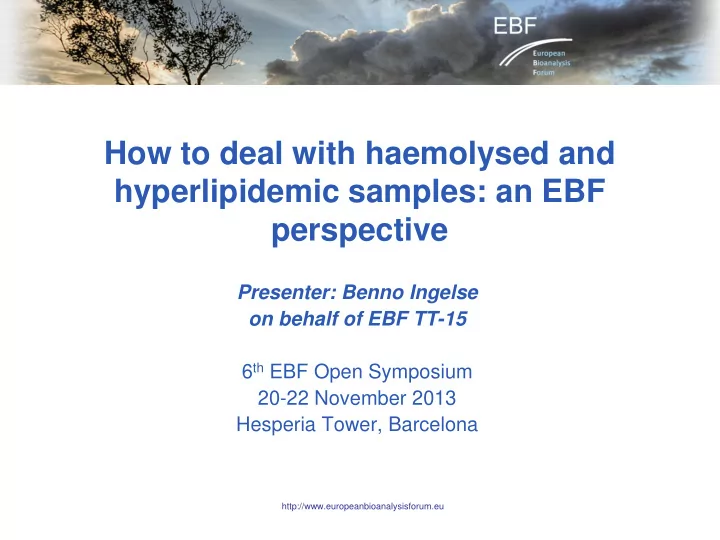

How to deal with haemolysed and hyperlipidemic samples: an EBF perspective Presenter: Benno Ingelse on behalf of EBF TT-15 6 th EBF Open Symposium 20-22 November 2013 Hesperia Tower, Barcelona http://www.europeanbioanalysisforum.eu
Introduction EMA requires investigation of haemolysed / hyperlipidemic matrices Feedback after EMA guidance: many things still unclear Many companies are still looking how to implement this new requirement http://www.europeanbioanalysisforum.eu 2
Content Guidance Definitions & recommendations Validation acceptance criteria & recommendations Study samples Summary http://www.europeanbioanalysisforum.eu 3
Content Guidance Definitions & recommendations Validation acceptance criteria & recommendations Study samples Summary http://www.europeanbioanalysisforum.eu 4
EMA / FDA Guidance “In addition to the normal matrix it is recommended to investigate matrix effects on other samples e.g. haemolysed and hyperlipidaemic plasma samples. For each analyte and the IS, the matrix factor (MF) should be calculated for each lot of matrix, (……) . The CV of the IS-normalised MF calculated from the 6 lots of matrix should not be greater than 15 % Appropriate steps shoud be taken to ensure the lack of matrix effects (…..) Matrix effects on ion suppression or enhancement or on extraction efficiency should be addressed Selectivity is tested by spiking at least 10 sources of sample matrix at or near the LLOQ. These sources should include lipemic and haemolysed samples . http://www.europeanbioanalysisforum.eu 5
Content Guidance Definitions & recommendations Validation acceptance criteria & recommendations Study samples Summary http://www.europeanbioanalysisforum.eu 6
Definitions / recommendations Haemolysed plasma 243 validations: 3 failures on haemolysis data Internal data (TT): < 0.3% of samples are >2% haemolysed Survey results (majority > 60%): • (min) 2% blood to plasma • Blood from one donor • Single concentration 25/11/2013 hTT-sp://www.europeanbioanalysisforum.eu 7
Definitions / recommendations Hyperlipidemic plasma 1987 report of National Cholesterol Education Program, Adult Treatment Panels The American Heart Association, total cholesterol levels Use matrix with ≥ 240 • mg/dL (total) cholesterol available from a commercial source • Be mindful of: • alcohol abuse • Diabetes • Kidney disease • Liver disease • hypothyroidism 25/11/2013 hTT-sp://www.europeanbioanalysisforum.eu 8
Definitions / recommendations Haemolysed: – 2 % blood to plasma (≈ 60%) – Prepared in own lab ( 75%) – Blood from one donor (60%) – Single concentrations (68%) Hyperlipidemic: – >240 mg/ dL Cholesterol – Commericially available (≈ 70% of labs that test ) – Blood from one donor (66% of labs that test ) – Single concentration (68% of labs that test) 25/11/2013 hTT-sp://www.europeanbioanalysisforum.eu 9
Content Guidance Definitions & recommendations Validation acceptance criteria & recommendations Study samples Summary http://www.europeanbioanalysisforum.eu 10
Validation & acceptance criteria • EMA guidance requires investigation of matrix effect • Draft FDA guidance requires extraction efficiency PlasmaLot # ME 1 1.01 2 0.95 3 0.97 4 1.06 5 1.07 6 1.01 Haemolysed 7 1.03 Hyperlipidemic 8 1.40 Precision 14% Accepted according to EMA guidance 25/11/2013 hTT-sp://www.europeanbioanalysisforum.eu 11
Validation & acceptance criteria Recommended to perform a QC-like experiment (single lot, QC-low, n=5, criteria on precision and accuracy) Haemolysed Current Prefered 45% 60% QC 32% 40% Matrix 23% 0% Nothing Hyperlipidemic Current Prefered 19% 50% QC 29% 40% Matrix 52% 10% Nothing 25/11/2013 hTT-sp://www.europeanbioanalysisforum.eu 12
Content Guidance Definitions & recommendations Validation acceptance criteria & recommendations Study samples Summary http://www.europeanbioanalysisforum.eu 13
How to deal with study samples? Monitor samples? How to monitor? Visual Yes No Color chart Analyser How do you report haemolysed / hyperlipidemic samples? Validation passes? Validation failed? Flag Flag No Flag NR http://www.europeanbioanalysisforum.eu 14
Study samples recommendations After succesfull validation do not monitor study samples Do not flag affected study samples Do not report data for affected samples if validation fails http://www.europeanbioanalysisforum.eu 15
EBF recommendations http://www.europeanbioanalysisforum.eu 16
Haemolysed Matrix Test one source of haemolysed matrix during validation Prepare by the addition of haemolysed blood # to control plasma (min. 2% v/v) Check for the absence of interference in blank haemolysed matrix : Prepare test QCs at QC low and analyse (min 5 reps) on one occasion (i.e. in a single validation run) (additional levels are allowed) Apply usual acceptance criteria: – Pass : Document in appropriate SOP(s) that 2% (or level tested) haemolysed matrix is considered to be reflective of haemolysed study samples, requiring no further action during analysis of unknown samples – Fail : Consider testing multiple sources of haemolysed matrix, multiple QC levels or modify methodology as required. If matrix effect due to haemolysis cannot be resolved, then method is not suitable for analysis of haemolysed samples and data for affected samples cannot be reported. # Haemolysed blood typically prepared by subjecting control whole blood to three freeze-thaw cycles
Hyperlipidemic Matrix Test one source of hyperlipidemic matrix during validation Use matrix with ≥ 240 mg/ dL (total) cholesterol available from a commercial source (be mindful of disease state op population) Check for the absence of interfering peaks in blank matrix Prepare test QCs at QC low and analyse (min 5 reps) on one occasion (i.e. in a single validation run) Apply usual acceptance criteria: – Pass : Document in appropriate SOP(s) that matrix with 240 mg/dL cholesterol is considered to be reflective of hyperlipidemic study samples, requiring no further action during analysis of unknown samples. Consider additional testing at a higher lipid content if considered necessary based upon disease state and patient population – Fail : Consider testing multiple sources of matrix, or modify methodology as required. If matrix effect due to lipid content cannot be resolved, then method is not suitable for analysis of hyperlipidemic samples and data for affected samples cannot be reported
In addition Recommended to test special matrices early during assay validation or development
Acknowledgement TT-15: – Begoña Barroso – Clare Kingsley – Corinna Sykora – Nicholas Gray – Steve White – Petra Vinck – Verena Jacob-Rodamer EBF community http://www.europeanbioanalysisforum.eu 20
Recommend
More recommend